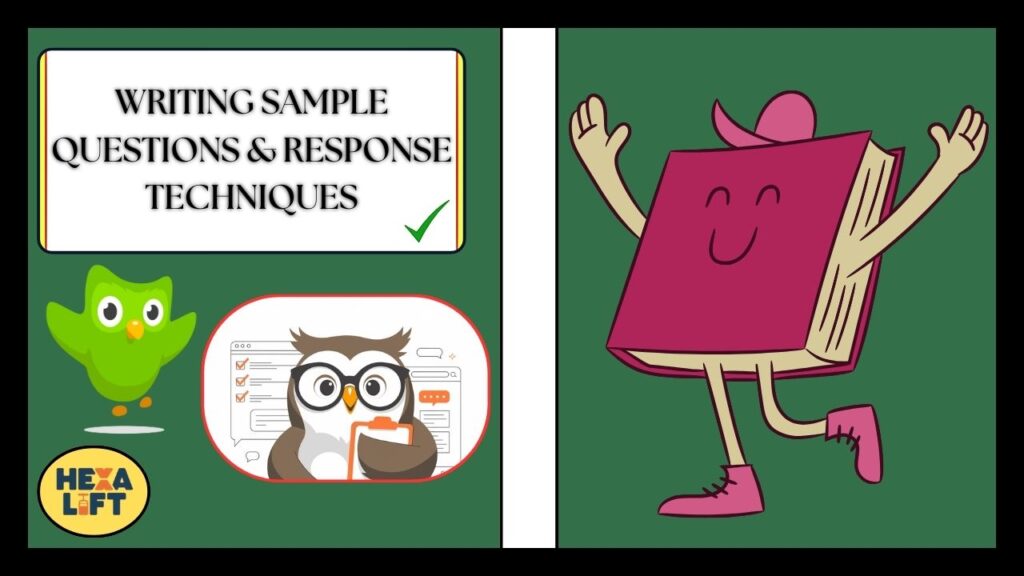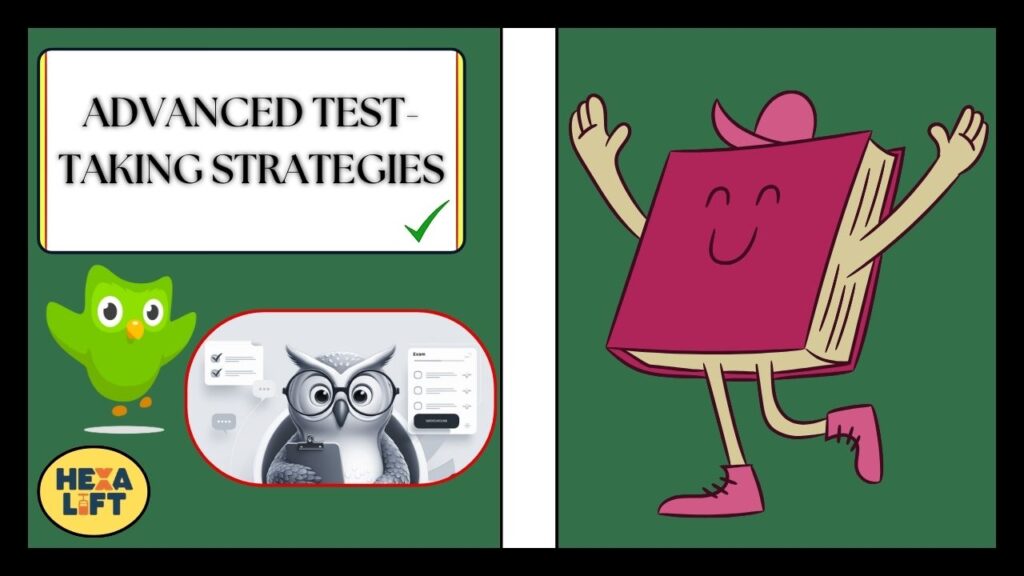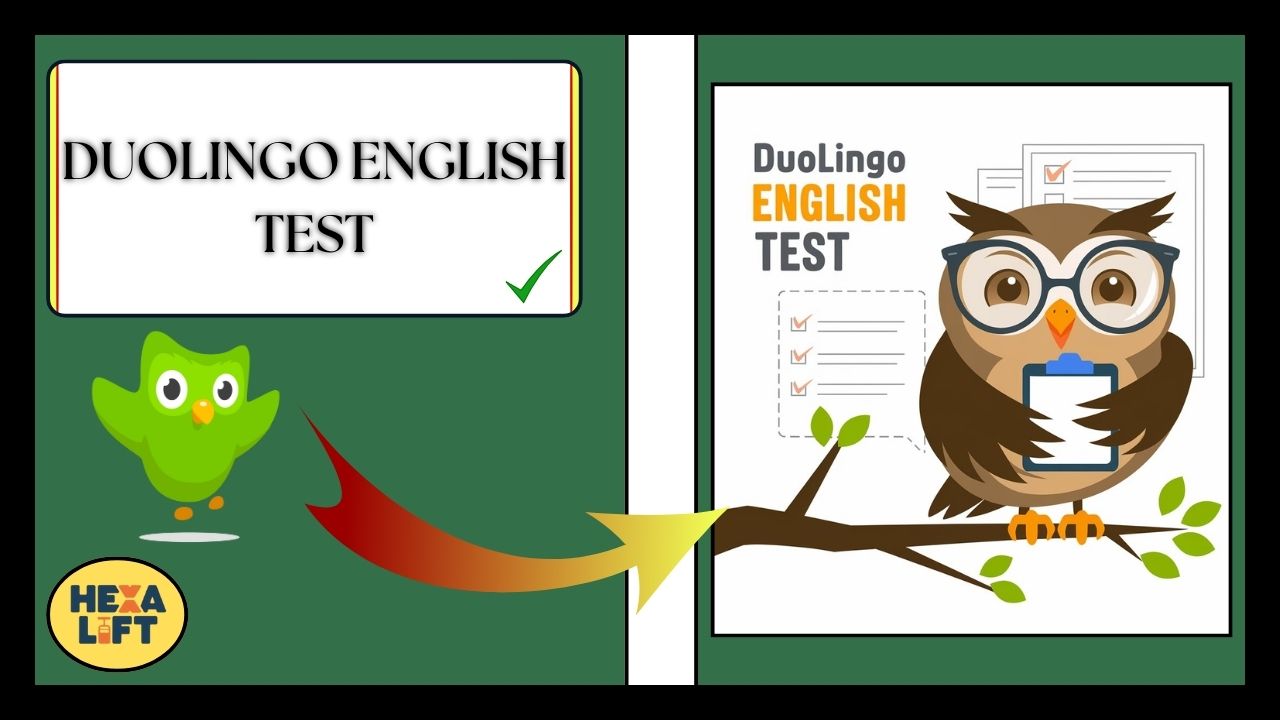Duolingo English Test Guide: The Duolingo English Test has rapidly emerged as a game-changer in the world of English proficiency testing.
Unlike traditional exams that require test centers and rigid scheduling, this innovative adaptive test offers convenience, affordability, and quick results.
But don’t mistake accessibility for simplicity this test demands thorough preparation and familiarity with its unique format.
In this comprehensive guide, we’ll dive deep into everything you need to know about the Duolingo English Test.
From understanding its structure to mastering each section with real sample questions and answers, we’re covering all bases.
Whether you’re applying to universities abroad or seeking professional certification, this resource will equip you with the strategies and practice materials needed to achieve your target score.
“Success on the Duolingo English Test isn’t just about English skills it’s about understanding the test’s unique format and approaching each question strategically.” Experienced DET tutor
What makes this guide different is our focus on authentic practice combined with insider strategies.
We’ve analyzed thousands of test experiences to bring you the most effective preparation approach possible. Let’s begin your journey toward DET success!
Understanding the Duolingo English Test
The Adaptive Format Explained
The Duolingo English Test stands apart from traditional exams by using a computer-adaptive test format. This means the test actually changes based on how you perform.
When you answer a question correctly, the next one becomes more challenging. When you answer incorrectly, subsequent questions become easier.
This adaptive nature serves two crucial purposes:
- It identifies your exact proficiency level with fewer questions
- It prevents test-takers from wasting time on questions far above or below their abilities
The entire test experience consists of two main parts:
- Main test section (45 minutes): The scored portion testing all four language skills
- Video interview section (15 minutes): Ungraded responses sent to institutions for additional evaluation
Here’s what makes the format particularly unique:
| Feature | How It Works | Why It Matters |
|---|---|---|
| No fixed question set | Questions drawn from a large item bank | Each test experience is unique |
| Unpredictable sequence | Skills tested in random order | Tests ability to switch between skills |
| No going back | Cannot review or change previous answers | Forces decisive answering |
| Continuous timing | Clock runs throughout the entire test | Requires efficient time management |
The adaptive approach means the test typically contains 35-45 items, though this varies based on your performance. This makes test format familiarity absolutely crucial for success.
Core Language Skills Assessment Areas
The Duolingo English Test holistically evaluates four fundamental language skills:
- Reading: Assessing comprehension of written English
- Writing: Evaluating your ability to produce clear, coherent text
- Speaking: Testing pronunciation, fluency, and verbal expression
- Listening: Measuring your ability to understand spoken English
Rather than having distinct sections for each skill, the test integrates these throughout. You might encounter a speaking task immediately followed by a reading question, then a listening exercise.
This randomized approach tests not just your skills but your ability to quickly shift between them.
Each skill contributes to your overall score, which ranges from 10-160. Most universities require scores between 100-125, which roughly corresponds to IELTS 6.5-7.5 or TOEFL 90-110.
Vocabulary and grammar are assessed across all sections rather than in isolation, giving a more authentic picture of your language proficiency. This integrated approach better reflects how language is used in academic environments.
Also Read: Duolingo Max Price: The Comprehensive Guide For 2025
Sample Reading Comprehension Questions & Strategies
Reading exercises on the DET come in several distinct formats. Let’s explore each with sample questions and effective strategies.
Vocabulary Identification Tasks
Sample Question: Select the word that means “to examine something carefully”:
- A) Scrutinize
- B) Fabricate
- C) Embellish
- D) Extrapolate
Answer: A) Scrutinize
Strategy: When approaching vocabulary questions, consider:
- Roots and affixes for word meaning clues
- Eliminating obviously incorrect options first
- Using context from your own knowledge
- Looking for synonyms you recognize
These questions test both breadth and depth of vocabulary knowledge. Regular reading in English and vocabulary-building exercises are essential for preparation.
C-Test Completion Exercises
Sample Question: Complete the text by filling in the blanks:
The res________ showed that stu________ who prac________ regularly perfo________ better on exa________.
Answer: The research showed that students who practiced regularly performed better on exams.
Strategy:
- Read the entire passage first to understand the context
- Look for grammatical clues (tense, plural/singular)
- Consider collocations (words that often appear together)
- Check that your completed sentence flows naturally
C-tests measure your comprehension of language patterns and your ability to infer missing information key academic skills.
Reading Passage Questions
Sample Question: Read the passage and answer the question:
Climate scientists have long warned about the potential consequences of global warming, including rising sea levels, more frequent extreme weather events, and disruptions to ecosystems. However, recent studies suggest that some effects may be occurring faster than previously predicted. Arctic ice, for example, is melting at rates that weren’t expected until the middle of this century.
Which statement is supported by the passage?
- A) Global warming has no real consequences
- B) Climate scientists have been exaggerating the effects of climate change
- C) Some climate change impacts are happening more quickly than anticipated
- D) Arctic ice is melting slower than expected
Answer: C) Some climate change impacts are happening more quickly than anticipated
Strategy:
- Identify the main idea and supporting details
- Distinguish between stated facts and inferences
- Look for signal words that indicate relationships between ideas
- Avoid answers that contain extreme language (“always,” “never”)
Reading passages test your ability to process academic text quickly a crucial skill for university studies.
Yes/No Reading Verification
Sample Question: Read the sentence and determine if it makes sense:
“The bicycle flew across the ocean carrying a suitcase full of dreams.”
Yes or No?
Answer: No
Strategy:
- Focus on logical consistency and reality
- Check for semantic contradictions
- Don’t overthink these questions test basic comprehension
- Trust your initial reaction overthinking often leads to errors
These seemingly simple questions require rapid linguistic processing and solid grasp of reality vs. fantasy in language.

Writing Sample Questions & Response Techniques
The writing section evaluates your ability to express ideas clearly and coherently. Here are the main question types with examples and response strategies.
Extended Writing Prompts
Sample Question: Write an essay about the following topic:
Do you think technology has made communication between people better or worse? Give reasons and examples to support your opinion.
Model Response: Technology has transformed communication in ways both positive and negative. On one hand, tools like video calls and messaging apps have bridged geographical gaps, allowing instant connection regardless of distance.
My grandmother in rural India now video chats with our family in America weekly something unimaginable a generation ago.
However, these same technologies have sometimes reduced the depth of our interactions. Face-to-face conversations are increasingly replaced by brief texts or emoji reactions.
I’ve noticed in my own university cafeteria that groups of friends often sit together while individually scrolling through their phones.
The quality of technological communication ultimately depends on how we use these tools. When we leverage technology to enhance rather than replace meaningful interaction like using group chats to organize in-person meetings or video calls to maintain long-distance relationships it enriches our connections.
But when we allow digital convenience to substitute for genuine engagement, our communication suffers.
In balance, I believe technology offers tremendous potential to improve communication, but requires conscious effort to ensure quality isn’t sacrificed for convenience.
Strategy:
- Plan briefly before writing (30 seconds)
- Create a clear structure (intro, body paragraphs, conclusion)
- Use specific examples from personal experience
- Demonstrate range in vocabulary and grammar
- Stay on topic and answer the question directly
- Maintain paragraph cohesion with transition phrases
- Aim for 200-300 words
Short Written Response Examples
Sample Question: Describe this image in 3-5 sentences: [Image shows a busy farmer’s market with vendors selling fruits and vegetables]
Model Response: The bustling farmer’s market features numerous vendors displaying colorful arrays of fresh produce under white canopies.
Customers of various ages browse among the stalls, examining fruits and vegetables while carrying reusable shopping bags.
Some shoppers are engaged in conversation with the vendors, likely inquiring about the origin or farming methods of the products.
The atmosphere appears lively and community-oriented, with the market seemingly located in an urban plaza or street closed to vehicle traffic.
Strategy:
- Begin with a general description of the main elements
- Include specific details about people, objects, and actions
- Mention relationships between elements in the image
- Use varied sentence structures and descriptive vocabulary
- Stay objective and avoid unnecessary interpretation
Short writing tasks test your ability to communicate clearly and efficiently crucial for academic and professional settings.
Speaking Section Challenges & Solutions
The speaking portion of the Duolingo English Test evaluates pronunciation, fluency, and verbal expression. Here are the key question types and strategies for success.
Read-Aloud Sample Passages
Sample Question: Read the following passage aloud:
The development of sustainable energy sources has become increasingly important as concerns about climate change continue to grow. Scientists around the world are working to improve solar panels, wind turbines, and other renewable technologies.
Strategy:
- Preview the text quickly before speaking
- Maintain natural pace and appropriate pauses
- Pay attention to word stress and sentence intonation
- Articulate clearly but don’t over-pronounce
- Practice with a variety of texts to build fluency
This task measures your ability to pronounce English clearly and naturally, with attention to rhythm and stress patterns.
Picture Description Tasks
Sample Question: Look at this image for 5 seconds, then describe it in as much detail as possible: [Image shows a classroom with students working in small groups]
Model Response Framework: This image shows a classroom setting where approximately 15-20 students are engaged in small group activities.
The students appear to be high school or university age and are seated in clusters of 3-4 around tables. A teacher or instructor is standing near one group, seemingly providing guidance or answering questions.
The classroom has several educational posters on the walls and looks well-equipped with modern learning materials.
The students seem actively engaged in discussion, suggesting they might be working on a collaborative project or problem-solving exercise.
Strategy:
- Start with the main subject and setting
- Structure description logically (general → specific)
- Mention people, objects, actions, and relationships
- Use diverse descriptive vocabulary
- Practice speaking about images under time pressure
Picture descriptions test your ability to observe and verbally express details quickly an important skill for academic discussions and presentations.
Opinion Questions
Sample Question: “Do you think public transportation should be free? Explain your reasoning.”
Model Response Template: Regarding free public transportation, I believe there are compelling arguments on both sides.
From one perspective, eliminating fares would increase accessibility for lower-income residents, potentially reduce traffic congestion, and decrease urban pollution levels. I’ve seen in cities with affordable transit how it enhances mobility for everyone.
However, this approach raises important questions about sustainable funding. Without fare revenue, transportation systems would require increased taxation or budget reallocation from other essential services.
The quality of service might also suffer without dedicated funding streams.
On balance, I support a hybrid approach perhaps offering free services to certain populations like students and seniors, while maintaining affordable fares for others. This would balance accessibility with financial sustainability.
Strategy:
- Present multiple perspectives
- Support with specific examples or reasoning
- Structure clearly with transitions between ideas
- Demonstrate critical thinking and nuance
- Practice expressing opinions on varied topics to build fluency
Opinion questions assess your ability to articulate and support a viewpoint essential for academic writing and discussion.
Also Read: Where Is The Practice Button On Duolingo? Complete Guide (2025)
Listening Comprehension Sample Questions
The listening section tests your ability to understand spoken English in various contexts. Here are the major question types and effective approaches.
Dictation Exercises
Sample Question: Listen to the audio and type exactly what you hear: [Audio plays]: “Environmental scientists are concerned about the long-term effects of plastic pollution in oceans.”
Strategy:
- Focus intently during the brief audio segment
- Type exactly what you hear, including punctuation
- If uncertain about a word, make your best guess and continue
- Practice transcribing various speakers, including different accents
- Develop keyboard familiarity to type quickly and accurately
Dictation measures your ability to process and reproduce spoken English precisely a key skill for academic lectures.
Audio Comprehension Questions
Sample Question: Listen to the lecture excerpt and answer the question: [Audio plays a 30-second lecture about renewable energy]
What was the main point of the lecture?
- A) Solar power is more efficient than wind power
- B) Renewable energy sources are becoming more affordable
- C) Government subsidies are essential for green energy
- D) Climate change requires immediate action
Strategy:
- Listen for main ideas and supporting details
- Take brief notes on key points and examples
- Pay attention to emphasis, tone, and transition words
- Practice active listening with academic lectures and discussions
Audio comprehension questions assess your ability to understand and extract key information from spoken content crucial for academic success.
Audio Summary Tasks
Sample Question: Listen to the conversation and summarize the main points in 2-3 sentences: [Audio plays a conversation about urban planning challenges]
Model Response: “The speakers discuss challenges in modern urban planning, particularly the tension between developing affordable housing and preserving green spaces.
They explore potential solutions including mixed-use zoning, public transportation expansion, and vertical gardening initiatives.
Both agree that successful urban development requires balancing economic growth with environmental considerations and community needs.”
Strategy:
- Identify the topic and main points quickly
- Note the relationship between speakers and their perspectives
- Focus on conclusions and agreed-upon points
- Practice summarizing various types of conversations and discussions
Summary tasks evaluate your ability to synthesize information from spoken exchanges an essential skill for academic discussions and professional settings.

Advanced Test-Taking Strategies
Success on the Duolingo English Test requires more than language skills strategic approaches to the test itself are crucial.
Adaptive Test Navigation
The adaptive nature of the DET presents unique challenges. Here’s how to navigate it effectively:
- Answer decisively: Since you can’t return to previous questions, make your best choice and move forward.
- Maintain consistent focus: The random ordering of question types requires quick mental shifting.
- Accept difficulty variation: If questions seem very difficult, it might actually indicate you’re performing well.
- Don’t rush or dawdle: Aim for a steady pace throughout.
“The key to success on adaptive tests is maintaining consistent performance regardless of perceived difficulty. Every question matters.” Language testing expert
Proctoring Requirements and Environmental Setup
The DET is remotely proctored through your computer’s camera and microphone.
To ensure a smooth experience:
- Technical setup:
- Use a reliable internet connection
- Test your camera and microphone beforehand
- Close all unnecessary applications
- Disable notifications and updates
- Environmental requirements:
- Choose a quiet, well-lit room
- Clear your desk of all materials
- Ensure you’ll be uninterrupted for the full hour
- Have your ID ready for verification
Failure to meet these requirements can result in test cancellation, so proper preparation is essential.
Cognitive Strategies for Handling Test-Day Anxiety
Test-day anxiety can significantly impact performance.
These techniques can help manage stress:
- Visualization: Practice imagining successful test completion
- Breathing exercises: Use 4-7-8 breathing (inhale for 4 counts, hold for 7, exhale for 8)
- Positive self-talk: Replace negative thoughts with constructive ones
- Preparation confidence: Remind yourself of your thorough practice
Remember that some nervousness is normal and can actually enhance performance when managed properly.
Also Read: Why Did Duolingo Icon Change: A New Look And Purpose
Practice Resources Breakdown
Effective practice is the cornerstone of test preparation. Here’s a comprehensive overview of available resources.
Official Duolingo Practice Test Analysis
The official Duolingo practice test provides the most authentic experience:
- Accurately represents current question types
- Demonstrates the adaptive test algorithm
- Provides sample score reports
- Offers limited free attempts
Key insight: While valuable, the official practice test should be used strategically perhaps once early in your preparation to identify weaknesses, and once closer to your test date to gauge improvement.
Third-Party Resources Evaluation
Not all third-party study tools offer equal value.
Here’s our assessment of common options:
| Resource Type | Strengths | Limitations | Recommendation |
|---|---|---|---|
| Prep books | Comprehensive coverage, structured approach | May not reflect recent updates | Supplement with online resources |
| Mobile apps | Convenient practice, gamified learning | Often focus on general English rather than test-specific skills | Use for vocabulary and grammar practice |
| YouTube channels | Free, visual demonstrations of strategies | Quality varies widely | Select channels from experienced teachers with DET expertise |
| Online courses | Structured curriculum, expert guidance | Can be expensive | Worth considering for those targeting high scores or struggling with self-study |
Reddit communities dedicated to the Duolingo English Test offer valuable peer insights and recent test experiences but should be used alongside more structured resources.
Creating an Effective Practice Schedule
Develop a personalized study plan based on:
- Time available: Ideally 4-8 weeks of preparation
- Current proficiency: Take a diagnostic test to identify strengths/weaknesses
- Target score: Higher targets require more intensive preparation
- Learning style: Visual, auditory, or kinesthetic approaches
A balanced weekly schedule might include:
- Reading practice: 2-3 hours
- Writing practice: 2-3 hours
- Speaking practice: 2-3 hours
- Listening practice: 2-3 hours
- Mock tests: 1 full test weekly
- Review and analysis: 1-2 hours
Consistent practice across all skills yields better results than cramming or focusing exclusively on weaknesses.
Post-Test Considerations
Understanding what happens after you complete the Duolingo English Test is an important part of your preparation journey.
Score Reporting Timeline and Process
After completing the test:
- Initial score: Available within 48 hours
- Detailed score report: Includes overall score (10-160) and subscores for literacy, conversation, comprehension, and production
- Shareable results: Your scores can be shared with unlimited institutions for 2 years
- Video interview access: Institutions can view your unscored responses
The breakdown of subscores helps institutions better understand your specific language strengths and weaknesses.
University-Specific Score Requirements
Score requirements vary significantly between institutions:
| University Tier | Typical Score Requirement | IELTS/TOEFL Equivalent |
|---|---|---|
| Highly selective | 120-130 | IELTS 7.5-8.0 / TOEFL 100-110 |
| Selective | 110-120 | IELTS 7.0-7.5 / TOEFL 94-100 |
| Moderately selective | 100-110 | IELTS 6.5-7.0 / TOEFL 85-94 |
| Less selective | 85-100 | IELTS 6.0-6.5 / TOEFL 75-85 |
Always verify the exact requirements for your target institutions, as these can change and may vary by program.
Retake Strategies
If your score falls short of requirements:
- Analyze performance: Review your detailed score report to identify weak areas
- Wait period: You must wait 30 days before retaking the test
- Focused improvement: Target specific skill areas that lowered your score
- Practice conditions: Ensure your retake environment mimics your first attempt for consistency
Many test-takers achieve higher scores on second attempts, particularly after targeted practice in identified weak areas.
Real Test-Taker Experiences
Learning from others’ experiences provides valuable insights for your own preparation.
Success Stories and Lessons Learned
Case Study 1: From 95 to 125 Sarah, applying to graduate programs in the US, initially scored 95 below her target schools’ requirements.
She identified listening comprehension as her primary weakness and spent six weeks:
- Listening to academic podcasts daily
- Practicing dictation with TED talks
- Joining English conversation groups twice weekly Her focused approach raised her score to 125, exceeding her requirements.
Case Study 2: First-Time Success at 115 Miguel prepared for three months while working full-time:
- Created flashcards for vocabulary building
- Practiced speaking by recording himself daily
- Completed one full practice test weekly
- Joined language exchange platforms like Tandem His disciplined approach yielded a satisfactory first-attempt score.
Common Unexpected Challenges and Solutions
| Challenge | Solution |
|---|---|
| Technical issues during the test | Run the pre-test checks thoroughly; have backup devices charged and ready |
| Environmental interruptions | Inform household members; put up a “testing in progress” sign; use noise-canceling headphones |
| Unexpected question types | Regular review of official updates; practice with the widest variety of questions possible |
| Time pressure | Targeted practice with timed sections; develop a personal pacing strategy |
These real-world scenarios highlight the importance of thorough preparation beyond just language skills.
Also Read: Does Duolingo Send Threatening Messages? The Complete Guide
FAQ Section
Here are detailed answers to common questions about the Duolingo English Test.
What makes the Duolingo English Test different from TOEFL or IELTS?
The Duolingo English Test differs in several key ways:
- Convenience: Take it anytime, anywhere with internet access
- Duration: Complete in 60 minutes vs. 2-3 hours for traditional tests
- Cost: Significantly lower price ($49 vs. $200+ for competitors)
- Format: Computer-adaptive vs. fixed question sets
- Results: Available within 48 hours vs. 1-2 weeks
- Sharing: Unlimited institution sharing vs. limited reports
These features make it particularly appealing to students with time constraints, budget limitations, or those in locations with limited access to testing centers.
How exactly does the adaptive scoring system work?
The adaptive scoring system uses sophisticated algorithms to:
- Begin with medium-difficulty questions
- Adjust difficulty based on your performance
- Calculate proficiency level through item response theory
- Convert raw proficiency scores to the 10-160 scale
- Generate subscores for literacy, conversation, comprehension, and production
This approach allows for shorter tests that maintain high reliability and validity comparable to traditional, longer exams.
What equipment do I need to take the test?
Essential equipment includes:
- Computer (desktop or laptop) with working camera
- Reliable internet connection
- Quiet, well-lit environment
- Valid government-issued ID
- Chrome or Firefox browser (latest version)
- Minimum system specifications:
- Windows 8+ or macOS 10.12+
- 4GB RAM
- 1 Mbps internet connection
Mobile devices, tablets, and Chromebooks are not supported for taking the official test.
Can I use scratch paper or take notes during the test?
No. The test format prohibits:
- Taking notes
- Using scratch paper
- Having writing instruments visible
- Using external calculators or aids
The proctoring system monitors for these violations, which can result in invalidated scores.
Is the Duolingo English Test accepted by all universities?
Acceptance has grown dramatically, but varies by institution:
- Over 3,000 programs now accept DET scores
- Most major US universities accept it
- UK and Australian acceptance is growing but not universal
- Some institutions accept it only as a supplement to other tests
- Certain programs (especially medical and law) may have specific test requirements
Always verify acceptance with your specific target institutions and programs before relying solely on DET scores.
Conclusion
The Duolingo English Test offers a modern approach to language proficiency testing that balances convenience with academic rigor.
Its adaptive nature rewards strategic preparation and a holistic understanding of English rather than memorization or test-taking tricks.
Final Preparation Checklist
As your test day approaches, ensure you’ve:
- ✅ Completed multiple full-length practice tests
- ✅ Practiced all question types for each skill area
- ✅ Developed strategies for managing time effectively
- ✅ Tested your equipment and environment
- ✅ Verified your ID meets requirements
- ✅ Reviewed your target score requirements
- ✅ Scheduled your test with buffer days before application deadlines
Key Takeaways for Maximizing Your Score
- Understanding the format is equally important as language skills
- Practice with authentic materials rather than generic English resources
- Balanced preparation across all four skill areas yields the best results
- Time management during the test critically impacts scores
- Technical preparation prevents avoidable problems
- Confidence comes from thorough preparation, not last-minute cramming
“The best test-takers aren’t necessarily those with perfect English, but those who understand how to demonstrate their skills within the constraints of the test format.” DET preparation specialist
With thoughtful preparation and strategic practice using the sample questions and answers provided in this guide, you’re well-positioned to achieve your target score and advance toward your academic and professional goals.
Remember that the Duolingo English Test measures not just isolated skills but your ability to use English in integrated, authentic ways prepare accordingly, and success will follow.
Read more knowledgeable blogs on Hexa Lift

Holly Wallace is a Duolingo expert, providing insightful reviews, pricing details, and FAQs. She helps language learners navigate Duolingo effectively, making language learning accessible, engaging, and efficient for users of all levels.








